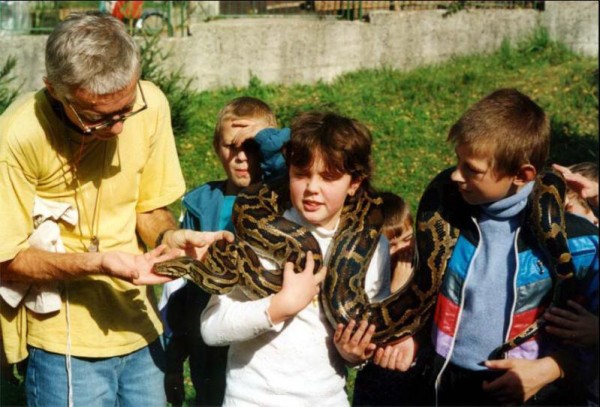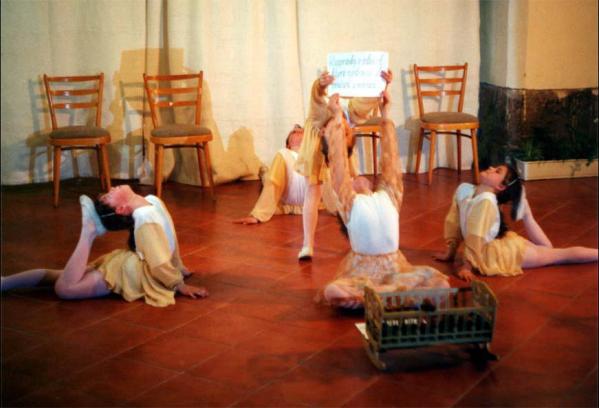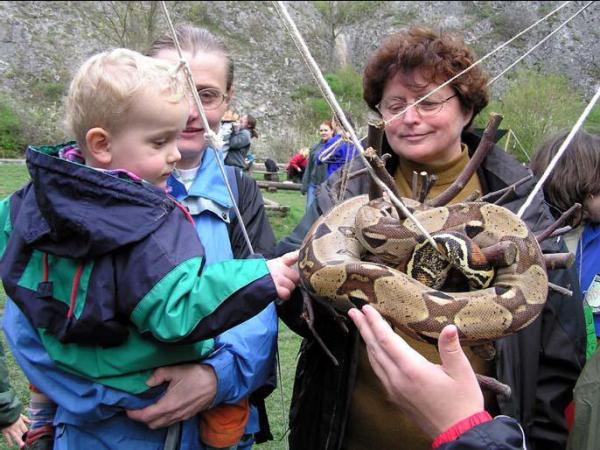BASIC ORGANISATION 01/68 OF THE CZECH UNION FOR NATURE CONSERVATION
PROTECTION
H E R P E T O F A U N A E

Jankovcova 47, 170 00 Praha 7 - Holešovice, Czech Republic
Our organisation tries to educate the public and to enhance their aproche to living nature using all means of education, including influence to the emotive part of people's psyche. Folowing report was printed in the magazine Natura montenegrina in the Republic of Montenegro in 2004.
NATURA MONTENEGRINA, PODGORICA, 3, 2004, I-VI
ARTEDUCATION
Ing. Jiří H A L E Š
This paper presents the initiative of Czech voluntary non-governmental non-profit organisation, the programme of which is mainly directed to herpetofauna protection.
In addition to indirect negative factors of development of civilization reptiles, especially snakes, and, for instance geckos – Gekonidae, are also endangered by the consequences of subjective deformations of opinion and respective behaviour of public, owing to traditional delusions and superstitions. These imaginations attribute to snakes the properties and behaviour which they in fact do not posses. This results in intended initiated destruction of species, which are mainly formally protected by law.
Practical enforcement of the laws on protection through punishment is not efficient, if it exists at all, and, moreover, it is not popular. Instead of punishment for the already made damage to the nature, there is another possibility – change through education the way of thinking and behaviour of the public to prevent damage and avoid punishment.
The choice of optimal strategy of education on need of nature protection is not simple, it needs to be adjusted to the species of treated subpopulation based on studies of local customs and microethnic properties, taking into consideration the age of majority of the participants, religion and similar current psychological factors. It is not difficult to form a sympathy of the public for different colour butterflies, song birds and similar popular animals. With snakes, on the contrary, it is not a small problem, and we can ask: why?...:

We have managed to define more exactly the origin of subjective negative relation towards the snakes, in addition to other psychometric experiments, by treatment of the results of a wide material obtained through the answers to the questionaire filled in by the visitors of a mobile exibition "Problems of Reptile Protection", presented in many places in Bohemia and Slovakia, but also in many places of former Yugoslavia Ljubljana, Zagreb, Rijeka, Plitvičkajezera, Travnik and Skopje. The results of this quiery have been presented at Etological Conference of Psychological Association of Checoslovakian Academy of Science, as well as at the third Congress of Croatian biologists in 1987.

The most significant result of the study has been the confirmation that mainly the assumed inborn and unchangeable squeamishness and disgust towards the snakes, in more than 90% of cases is in fact the consequence of imprinting, respectively transfer of this behaviour from one generation to another in the juvenile age, when the child does not form its reactions on basis of rational processes, but by subconscious copying of parents‘ or other adults‘ behaviour. Numerous experiments have also practically confirmed, that the squemishness towards the snakes, representing an significant obstacle to practical enforcement of the Law on Protection of Endangered Species, may be eliminated by application of optimal means of influence, and even altered in outstanding sympathies. The ability to change the subconscious relation decreases and it is motre difficult to implement it in growing age to the „patient“ the therapy is administered on.
 Ecoballet "Ominous Fairy by the Snake’s Craddle", author Anna Cehelská, Slovakia.
Ecoballet "Ominous Fairy by the Snake’s Craddle", author Anna Cehelská, Slovakia.
For that reason it is the most efficient to influence the children, replacing the inapropriate fairy tales about evil dragons and snakes by positive creatures – that is wheree our arteducation is directed.
Change of thinking and behaviour is possible to reach by different means. We can use the exact scientific information, but we have established that they are difficult to reach the general public, as they do not attract the interest. That is why we have attempted to use various means of emotional induction, which attracts primarily the interest, not by its contents, but by its form – like song, verses, acting ... and use thus attracted attention later for the reconstruction of the conventional way of thinking.
We have used this type of methodics and strategy especially in form of competition youth festivals "Cantata ecologica", organised on basis of our initiative not only in Bohemia, but also in Slovakia and Croatia, usually with participation of actors from all of these states. These festivals and their products have gradually exceeded by their importance the scope of their modest original project and they have been used several times in television and radio broadcasts – like, for example the song of a good dragon who saved a princess from an evil prince...
Our Center for Ecological Education of Youth had a similar course of activity and experience through a number of years; for the above mentioned purpose of arteducation we also utilize a part of the programme of our videostudio "Get to Know and Protect". It is interesting that also the adults, in order not to be considered by their own children as behindhand and primitive and striving not to loose their respect, had to adjust to modern tendencies of ecologization and desert their traditionally negative attitude towards the reptiles – here we have a paradoxal education of elderly by the youth.
Montenegro, thanks to its geomorphological and climatic diversity, for its biodiversity also in reptilian fauna, belongs to the greatest in Europe, so that this is an important component of fauna, but many species belong to the endangered ones. For that reason the reptiles deserve a respective attention. In practice, this unfortunately is not noticed. For example, at this symposium (The First Symposium of Ecologists of Montenegro) no paper from the temathic of herpetofauna was reported, just a poster presentation of a mere inventory of a valley (insufficiently significant from this viewpoint) and without any ecological observations or estamate, to which extent and in which way specific species are endangered and whjat needs to be done in order to help the survival of species.


On my way to this symposium I stopped at the locality Sasovići near Zelenika in Bay of Kotor, for which I had once attempted to propose th measures of protection towards 19 (!!!) reptile species in this region (in the slopes above the locality 2 additional species were recorded). In addition to private attempts of educational initiative I have also written an article published in The Bulletin of the Nature Protection Institution and Natural History Museum of Montenegro in Titograd, No 20, 1987-8. So far I have not noticed any reaction to my recommendation what would be neccesary to provide in order to preserve that locality from empoverishment. On the contrary, the inhabitant and cousin to Sasovići, Miodrag Šimrak has recently informed me that the inhabitants of a new week-end house, located in the middle of the former habitat of many species, have offered him money to come with his hunting gun and kill all the snakes in the surrounding of their building. This, unfortunately, is a typical example of the enforcement of the Law on Nature Protection in Practice. Formig of a cultural relation of the public towards this fauna is being late in Montenegro for some fifty years as compared with, for instance, Bohemia, where a number of local population takes care about some localities and species of herpetofauna in scope of non governmental organisations; they dig holes for forming water basins so that amphibians could have conditions for reproduction, for reptiles they make artificial winter shelters and nests for eggs... than, we have also passed the passive phase of „let them live“ to active assistance in their survival. Unfortunaltely, in Montenegro, one can not notice that even the first phase has started and there still prredominates an intended destruction of formally by the law protected species. Our non governmental organisation may offer especially to schools a videostudy „Get to Know and Protect Reptiles“ aimed at educating and upgrading of described situation; it consists of the survey of all Croatian species, which we have made, at the request of Croatian institutions and television also with comment in Croatian. Since Montenegro is populated by the same reptile species, it should possibly be neccessary to adjust the comment from the standpoint of grammar.
